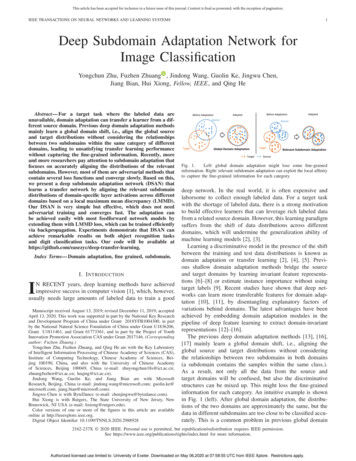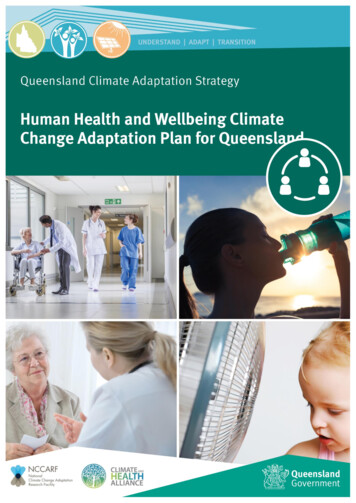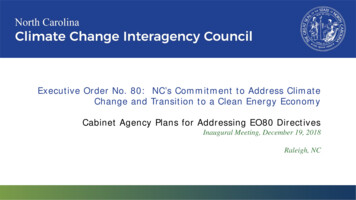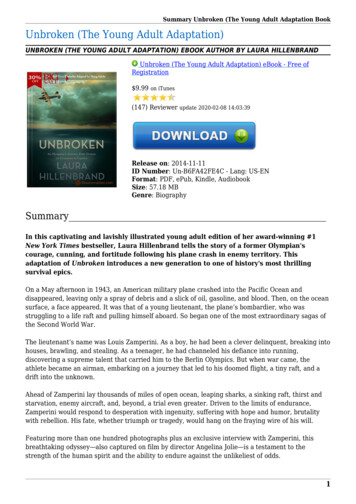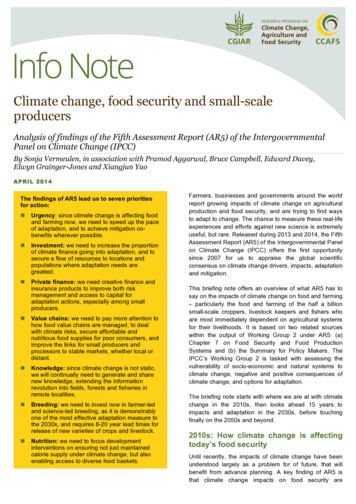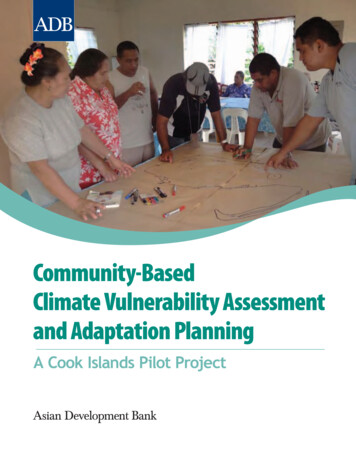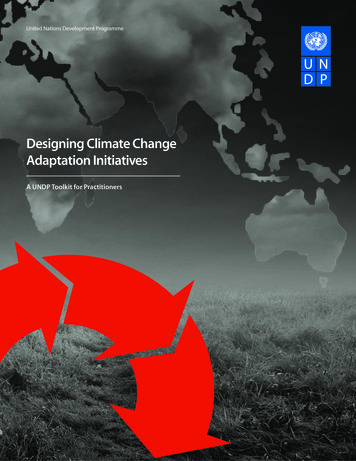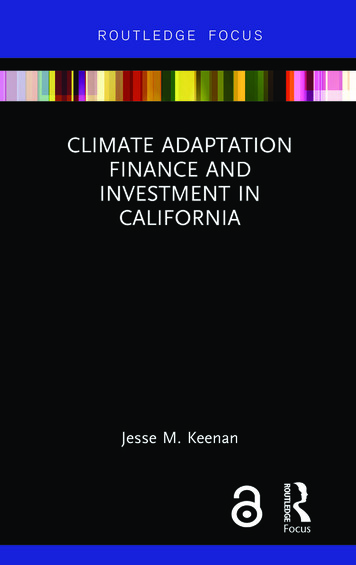
Transcription
Climate Adaptation Finance andInvestment in CaliforniaThis book serves as a guide for local governments and private enterprisesas they navigate the unchartered waters of investing in climate changeadaptation and resilience. This book serves not only as a resource guidefor identifying potential funding sources but also as a roadmap for assetmanagement and public finance processes. It highlights practical synergiesbetween funding mechanisms, as well as the conflicts that may arise betweenvarying interests and strategies. While the main focus of this work is on theState of California, this book offers broader insights for how states, localgovernments and private enterprises can take those critical first steps ininvesting in society’s collective adaptation to climate change.Jesse M. Keenan is a faculty member at the Graduate School of Designat Harvard University where he researches and teaches courses in climatechange adaptation and the built environment. Keenan concurrently servesas a Research Advisor for Climate Adaptation Finance to the Governor’sOffice of Planning and Research for the State of California and as a VisitingScholar at the Federal Reserve Bank of San Francisco.
Routledge Focus on Environment and SustainabilityClimate Change Discourse in RussiaPast and PresentEdited by Marianna Poberezhskaya and Teresa AsheThe Greening of US Free Trade AgreementsFrom NAFTA to the Present DayLinda J. AllenIndigenous Sacred Natural Sites and Spiritual GovernanceThe Legal Case for Juristic PersonhoodJohn StudleyEnvironmental Communication Among Minority PopulationsEdited by Bruno Takahashi and Sonny RosenthalSolar Energy, Mini-grids and Sustainable Electricity AccessPractical Experiences, Lessons and Solutions from SenegalKirsten Ulsrud, Charles Muchunku, Debajit Palit and Gathu KirubiClimate Change, Politics and the Press in IrelandDavid RobbinsProductivity and Innovation in SMEsCreating Competitive Advantage in Singapore and Southeast AsiaAzad Bali, Peter McKiernan, Christopher Vas and Peter WaringClimate Adaptation Finance and Investment in CaliforniaJesse M. KeenanFor more information about this series, please visit: nd-Sustainability/book-series/RFES
Climate AdaptationFinance and Investmentin CaliforniaJesse M. Keenan
First published 2019by Routledge2 Park Square, Milton Park, Abingdon, Oxon OX14 4RNand by Routledge52 Vanderbilt Avenue, New York, NY 10017Routledge is an imprint of the Taylor & Francis Group, an informa business 2019 Jesse M. KeenanThe right of Jesse M. Keenan to be identified as author of this workhas been asserted by him in accordance with sections 77 and 78 of theCopyright, Designs and Patents Act 1988.The Open Access version of this book, available at www.taylorfrancis.com, has been made available under a Creative Commons Attribution-NonCommercial-No Derivatives 4.0 license.Trademark notice: Product or corporate names may be trademarks orregistered trademarks, and are used only for identification and explanationwithout intent to infringe.British Library Cataloguing-in-Publication DataA catalogue record for this book is available from the British LibraryLibrary of Congress Cataloging-in-Publication DataA catalog record for this book has been requestedISBN: 978-0-367-02607-3 (hbk)ISBN: 978-0-429-39875-9 (ebk)Typeset in Times New Romanby Apex CoVantage, LLC
State of CaliforniaEdmund G. Brown Jr., GovernorGovernor’s Office of Planning and ResearchKen Alex, DirectorThis book may reference specific laws and regulations. Any such reference is provided merelyfor the convenience of the reader. Readers should always refer to the actual text of the applicable laws and regulations and consult with an attorney when interpreting and applying suchlaws and regulations. This book should not be construed as legal advice by the Governor’sOffice of Planning and Research (OPR). This book is based on a guide prepared for the Stateof California, Governor’s Office of Planning and Research.The opinions expressed represent the opinions of the author and principal investigator and notthose of the State of California, OPR or any parties affiliated with the research or productionof this book, including Harvard University or any of the persons, entities or organizations providing support to, or affiliated with, these aforementioned entities. The State of California andOPR make no warrant, express or implied, and assume no legal liability for the information inthis book; nor does any party represent that the uses of this information will not infringe uponprivately owned rights. This book has not been approved or disapproved by OPR nor has OPRpassed upon the accuracy or adequacy of the information in this report. For more informationon climate change resources, please visit opr.ca.gov or resilientca.org.
ContentsAcknowledgmentsPrefaceList of acronyms and abbreviationsList of figures, tables and boxesixxxixv1IntroductionHow to use this guide 2Momentum shaping adaptation finance 2What is resilience and adaptation? 4Challenges and opportunities of adaptation finance 1412Climate adaptation and asset managementAsset management processes 18Adaptation strategies 27From asset management to integrated portfoliomanagement 30Emerging barriers to execution 34183Funding and financing adaptationLocal government 37Public and private utilities 49State government 52Federal government 64Civic and private sectors 70Alternative funding models 7236
viii Contents4Assessing funding and financing optionsProject screening 76Evaluating funding sources 78Strategic positioning of projects 82755Social equity considerationsQuantitative weighting 85Qualitative evaluation 88856Private sectorRisks and opportunities 92Community resilience and business continuity 99927Climate servicesIndicators and activities 101Products and services 103Procurement considerations 1061018Moving forward109BibliographyAppendixList of online resourcesGlossaryIndex112124138146153
AcknowledgmentsI would like to acknowledge the tireless efforts of Nuin-Tara Key and theteam at the Governor’s Office of Planning and Research for their supportin researching and producing this book. I would also like to thank myresearch team at Harvard University, including Susanna Pho (Lead VisualDesigner), Carolyn Angius (Research Supervisor), Pamela Cabrera (Illustrator), Anurag Gumber (Researcher) and Jenny Fan (Graduate Researcher). Iwould also like to acknowledge Louise Bedsworth, Ken Alex, Brian Strong,John Moon, Laura Choi, Naomi Cytron, Lizzy Mattiuzzi, Laurel Gourd andthe Federal Reserve Bank of San Francisco for their support in researchingthis book. I am also grateful to Governor Jerry Brown, Sam Higuchi, AnnKosmal, Michael Bell, Bill Solecki, Cynthia Rosenzweig, Peter Huybers,Dan Schrag, Jim Clem, Radley Horton, Rachel Minnery, Judge Alice Hill,Joseph P. Kennedy II, Brian O’Connor, Peter Smith, Chris Flavelle, DavidMartin, Doug Parsons, Steven C. Cronig, Bud and Leslie Bell, David F.Jones, Eddie Lopez, Mike and Sue Keenan, Nathaniel and Lindsey Keenanand Kristen Keenan for their ongoing inspiration in advancing a world thatis more fair, just and knowledgeable in the face of climate change. This bookwas supported by generous grants from the Harvard University ClimateChange Solutions Fund and the Federal Reserve Bank of San Francisco.
PrefaceThis book serves as a guide for local governments and private enterprises asthey navigate the unchartered waters of investing in climate change adaptation and resilience. This guide is intended to serve not only as a resourceguide for identifying potential funding sources but also as a roadmap forasset management and public finance processes. It does so by framing whatquestions should be asked today of what might happen tomorrow. It highlights practical synergies between funding mechanisms, as well as the conflicts that may arise between varying interests and strategies. In particular,this guide provides available methods for ensuring that social equity considerations help shape fair and equitable investments.While this guide is intended to address an audience with a working knowledge of finance and investment, it also offers an accessible perspective onbasic concepts and ideas that challenge the assumptions of conventionalinvesting. To this end, asset managers, risk managers, underwriters, projectmanagers, planners, civic advocates and elected officials will all find valuein this guide, as they seek to invest in projects and programs that addressclimate change impacts. This guide is part of California’s commitment toproviding the most up-to-date knowledge for guiding the state’s climatefuture. Together, the public, private and civic sectors can work together tomaintain an intelligence about emerging markets, instruments and modelsthat serves to not only manage risks but also to take advantage of the manyopportunities for civic investment.Readers may use and interpret the information contained in this guide attheir sole discretion. Nothing in this guide should be construed as establishing any legal mandates or required actions.
Acronyms and GHADAverage Annual LossesCalifornia Assembly BillAgricultural Conservation Easement ProgramAffordable Housing and Sustainable Communities ProgramAmerican Society of Civil EngineersAmerican Water Works AssociationBlue Forest ConservationBusiness Improvement DistrictBetter Utilizing Investments to Leverage Development GrantsCapital Appreciation BondCalifornia Association of Geological Hazard AbatementDistrictsCALEDCalifornia Association of Local Economic DevelopmentCal EPACalifornia Environmental Protection AgencyCAL FIRE California Department of Forestry and Fire ProtectionCal OESCalifornia Office of Emergency ServicesCaltransCalifornia Department of TransportationCAPContinuing Authorities ProgramCARBCalifornia Air Resources BoardCat Bond Catastrophe BondCBACost-Benefit AnalysisCBIClimate Bonds InitiativeCCCCalifornia Coastal ConservancyCCFRFCommunity Choice Flood Risk FinancingCCICalifornia Climate InvestmentsCDBGCommunity Development Block GrantCDCCenters for Disease Control and PreventionCDFACalifornia Department of Food and AgricultureCDFICommunity Development Finance InstitutionCDFWCalifornia Department of Fish and Wildlife
xii Acronyms and CCCost-Effectiveness AnalysisCalifornia Energy CommissionCalifornia Environmental Quality ActCommunity Facilities DistrictCalifornia Forest Improvement ProgramCalifornia Lending for Energy and Environmental NeedsCenterCongestion Mitigation and Air Quality ImprovementCalifornia Natural Resources AgencyCalifornia Public Utilities CommissionChicago Transit AuthorityCalifornia Transportation CommissionUnited States Department of Homeland SecurityUnited States Department of EnergyDepartment of Parks and RecreationDepartment of Water ResourcesEnvironmental Enhancement and MitigationEnhanced Infrastructure Finance DistrictsEnvironmental Protection AgencyElectric Program Investment ChargeEnergy Service CompaniesExpected ValueFederal Emergency Management AgencyFlood Mitigation Assistance ProgramFinancial Stability BoardFederal Transit AdministrationGlobal Adaptation & Resilience Investment Working GroupGreenhouse Gas Reduction FundGeological Hazard Abatement DistrictGlobal Impact Investors NetworkGlobal Impact Investment Rating SystemGeneral ObligationGovernment of South AustraliaCalifornia Department of Housing and CommunityDevelopmentHazard Mitigation GrantsCalifornia Infrastructure and Economic Development BankCalifornia Integrated Climate Adaptation and ResiliencyProgramInternational Capital Market AssociationInfrastructure Finance DistrictIntergovernmental Panel on Climate Change
Acronyms and abbreviations SOM&ROMBOPCOPRPAPACEPDMPFAPG&EPVRBDRDMROAROIImpact Reporting and Investment StandardsIntegrated Regional Water Management PlanInfrastructure State Revolving FundLos Angeles County Regional Park and Open Space DistrictLegislative Analyst’s OfficeLifecycle Cost AccountingLow Carbon Transit Operations ProgramLimited English ProficiencyLesbian, Gay, Bisexual, Transgender, Queer and QuestioningLocal Hazard Mitigation PlanningLocalized Constructed AnalogsMulti-Criteria AnalysisMunicipal Securities Rulemaking BoardMetropolitan Transportation CommissionNational Association of Insurance CommissionersNational Disaster Resilience CompetitionNational Environmental Protection ActNational Flood Insurance ProgramNational Institute of Building SciencesUnited States National Institute for Standards and TechnologyNational Oceanographic and Atmospheric AgencyNet Present ValueOperations and MaintenanceCalifornia Governor’s Office of Emergency ServicesCalifornia State Parks’ Office of Grants and Local ServicesProgramOperation, Maintenance and RepairOffice of Management and Budget, President of the UnitedStatesCalifornia Ocean Protection CouncilOffice of Planning and Research, Governor of the State ofCaliforniaPortfolio AnalysisProperty Assessed Clean EnergyPre-Disaster Mitigation ProgramPublic Financing AuthorityPacific Gas and ElectricPresent ValueResilient by Design: Bay Area Challenge Finance Advisory TeamRobust Decision-MakingReal Options AnalysisReturn-on-Investment
xivAcronyms and SWFSWRCBTACTCCTIFTIRCPTRBU( aRWCBWRIRegional Resilience Assessment ProgramSpecial Assessment DistrictSustainable Agricultural Lands ConservationCalifornia Senate BillSecurities and Exchange CommissionStrategic Growth CouncilState Hazard Mitigation PlanSea Level RiseStrong, Prosperous and Resilient Communities ChallengeSouth West Climate Change PortalSocial Welfare FunctionsCalifornia State Water Resources Control BoardTechnical Advisory CouncilTransformative Climate CommunitiesTax Increment FinancingTransit and Intercity Rail Capital ProgramTransportation Research BoardIncremental UtilityUniversity of California San DiegoUnited States Army Corps of EngineersUnited States Bureau of ReclamationUnited States Department of AgricultureUnited States Department of TransportationUnited States Forest ServiceUnited States Fish and Wildlife ServiceUnited States Global Change Research ProgramUnited States General Services AdministrationUnited States Department of Housing and Urban DevelopmentValue-at-RiskCalifornia Wildlife Conservation BoardWorld Resources Institute
Figures, tables and boxesFigures1.1Conceptual relationship between risk mitigation,resilience, adaptation and failure1.2Engineering resilience curve relationship to adaptationin built assets1.3Balancing adaptation costs and benefits/avoided losses1.4Public investment in living shoreline1.5Private investment in a hospital2.1Decision tree for climate adaptation asset assessment2.2Risk prioritization matrix2.3Climate impacts on reserve accounting2.4Climate change-driven shift in mean and variance2.5Climate change-driven shift in tail risk2.6Impact-variable adaptation investment analysis2.7Relationship between threshold, lead time anddecision points3.1Landscape for adaptation funding and financing3.2Structure of a Catastrophe Bond3.3Structure of a Resilience Bond3.4Resilience ESCOs for micro-grid investments3.5California climate investments: legend3.6Natural resources and water diversion: public3.7Natural resources and water diversion: private3.8Clean energy and energy efficiency: public3.9Clean energy and energy efficiency: private3.10 Transportation: public3.11 Transportation: private3.12 Sustainable 636364
xvi4.15.15.26.17.1Figures, tables and boxesIterative analysis for assessing and weighting financingand funding optionsFunctions for elastic utility and equity weightsExample equity weights applied in a CBAClimate-related risk, opportunities and financial impactsMap of climate services 14.25.15.26.16.27.1A.1A.2A.3Common barriers to adaptation funding and financeExample of heuristics for occurrence likelihoodCurrent climate return analysisFuture climate return analysisExample adaptation strategies for flooding and sea level riseOpportunities to integrate climate change adaptation toasset management plans and policiesLifecycle priority definitions for public assetsExample of funding strategies heat mapExample framework for a multi-criteria assessment offunding optionsExample of the incremental utility of 1 in determiningequity weightsSPARCC capital screening evaluation criteria (2018)Timeframe and approach to assessing physical climate risksKey considerations for conducting a scenario analysisIndicators of climate change in CaliforniaAdaptation and resilience co-benefits with sustainabilityAdaptation strategies for asset managementPotential opportunities to embed climate change into theFEMA Hazard Mitigation Planning es1.11.22.12.22.33.15.1Public investment in a living shorelinePrivate investment in a hospitalClimate impacts on reserve accounting“Fat tails” and climate changeImpact-variable adaptation investment analysisResilience ESCOs for micro-grid investmentsApplying equity weights to a flood levee CBA9102223265088
1IntroductionThis book serves as a guide for local governments and private enterprisesas they navigate the unchartered waters of investing in climate changeadaptation and resilience. Local governments and private enterprises in theState of California have made tremendous strides in developing an adaptivecapacity for addressing the current and future impacts of climate change.Both the public and private sectors have been united in their challenge tonot only conceptualize the economic consequences of climate change butalso to develop a practical set of methodologies and criteria for evaluatinginvestments undertaken in the name of adaptation and resilience. Throughsuccessive adaptation plans and updates for nearly the past decade, theState of California has made advances in framing investment challengesand interventions in everything from transportation finance to disasterrecovery grants and from life-cycle asset management to structured finance(CNRA 2009, 2016, 2018a). The 2018 update to the state adaptation planhas called for not only advancing innovation in financing models butalso the incorporation of climate adaptation into existing funding sources(CNRA 2018a, p. 88).Advanced in coordination with the California Integrated Climate Adaptation and Resiliency Program (ICARP) Technical Advisory Council (TAC)and the Federal Reserve Bank of San Francisco, this guide seeks to provideinsight into how local governments, as well as private enterprises, may strategically develop financial models based on a variety of funding sources,analytical methods and strategic motivations. In this regard, the challengeis not only to fund “climate” projects but also to fund every day projectsthat seek to incorporate some aspects of resilience and/or adaptation performance into their design standards and investment underwriting criteria. Fromanother perspective, this guide helps provide a methodology for underwriting resilience and adaptation considerations in projects that serve a varietyof interests and social equities over a variety of time horizons. Consistentwith the principles of the ICARP-TAC and its authorizing legislation, it is
2Introductionincumbent upon stakeholders to evaluate the distributive costs and benefitsthat shape the social, economic and environmental welfare of vulnerablecommunities. As such, this guide provides methods for ensuring that socialequity considerations help shape fair and equitable investments.The broad intent is to develop a sensitivity in underwriting and managinginvestments that provide transparency for investors and the general publicabout the nature of trade-offs by and between different options and strategies.As will be discussed, these trade-offs may be between investing in short-termresilience and long-term adaptation or simply between the conflicts that mayarise between the built and natural environments. The intent is to empowerlocal governments to not only develop innovative finance models but also tocommunicate the value of such investments to the general public, as well asthose who are the stewards of managing assets. As such, this guide attemptsto think beyond the immediacy of return-on-investment (ROI) analysis infavor of a multitude of quantitative returns and qualitative benefits.How to use this guideThis guide is intended to provide a survey of issues, considerations andsources of funding that can help guide strategies and tactics for investingin adaptation and resilience in California. While this guide is primarily oriented for asset management, public accounting, risk management and transactional finance actors within local governments, it may also be insightfulfor actors engaged in community development and investment; state agencies interested in developing adaptation finance products or conduits; and,private sector financiers and underwriters who recognize the opportunitiesassociated with responsible investing in climate change. The intent of thisguide is not to provide a prescriptive pathway or underwriting process but tochallenge the assumptions and values of existing modes of analysis, as wellas to highlight novel ideas and developments that are likely to have bearingon future investments. By orienting adaptation finance to existing conventions, the guide is intended to reflect on the proposition that the “finance”in adaptation finance is relatively straightforward. The more fundamentalchallenge is in identifying the sources of funding that will allow for newcapital stacks that account for the divergent interests and returns associatedwith a new form of investment.Momentum shaping adaptation financeThis guide builds off of the work of a variety of California-specific resourcesthat have sought to mobilize greater analytical sensitivity and issue awareness associated with current and future climate adaptation investment
Introduction 3challenges. Pursuant to Executive Order B-30–15, the Planning and Investing for a Resilient California: A Guidebook for State Agencies (OPR 2017)provides a generalizable process for assessing climate impacts and risksin projects, as well as a variety of conceptual models for advancing datainformed decision-making processes. This accessible process is contextualized within permitting and economic analysis tasks within existing policyregimes, including the California Environmental Quality Act (CEQA) andNational Environmental Protection Act (NEPA). Most importantly, thisguide provides specific benchmarks, climate data sets and methodologiesfor accessing and utilizing climate services, including downscaled models that are most appropriate for California. This is an important resourcebecause it sets the standards for normalizing data that allows for an assessment of risk and opportunity by and between similarly situated alternativeinvestment options. In addition, this also serves to create a benchmark forbest practices consistent with local planning and design standards that mustindependently have concurrency with investment underwriting criteria.Adaptation finance has also been the object of research through theFourth California Climate Assessment. As will be discussed in more detailin Chapter 2, Adaptation Finance Challenges: Characteristic Patterns Facing California Local Governments and Ways to Overcome Them (Moser,Ekstrom, Kim, & Heitsch 2018) has provided significant insight into notonly understanding potential innovations but also how those innovationsmay be constrained by virtue of institutional, administrative, communication and legal barriers. More fundamentally, however, the research highlighted that “there [are no] estimates available for California (or any state)for how much money has been spent on adaptation to date and how muchmore is needed to support local adaptation” (id., p. 2).With this uncertainty in mind, it can be argued that, without even knowingthe range for the overall projected need, it is necessary to shift the framingfrom an optimization (e.g., economic growth vs. averted losses/adaptationcosts) for the allocation of limited resources to a qualitative framing thatseeks to develop a robust capacity for mainstreaming within a variety ofsector-specific capacities for funding adaptation interventions (Dittrich,Wreford, & Moran 2016; Heal 2017). While models do exist for estimatinga range of economic losses from climate change (Hsiang et al. 2017; Tol2018), this is not the same as estimating project life-cycle impacts that mayhighlight asset impairment that otherwise suggests increased or novel risksand opportunities associated with collateral valuation and credit risk (FSB2017a; Ernst & Young 2017).Pursuant to Executive Order B-30–15, state agencies are already requiredto evaluate full life-cycle cost accounting (LCCA). Further, pursuant to stateguidance, this LCCA should be inclusive of not only design and performance
4Introductioncriteria that reflect a changing climate but also an incorporation of costsassociated with the operations, maintenance and repairs (OM&R) of thoseassets (OPR 2017). This should include estimates for performance underconditions of climate stress and resilience costs associated with continuityand recovery following extreme events or shocks. In addition to these policy considerations, model uncertainty also raises the question as to whetherdeterministic net present value (NPV) methodologies such as cost-benefitanalysis (CBA) are adequate in light of the proposition that many criticalconditions and assumptions are likely to change following an initial underwriting (Watkiss, Hunt, Blyth, & Dyszynski 2015). For instance, how wouldthe NPV payback period for a resilience investment change within a LCCA,if temperatures increase faster than was modeled?While this guide will primarily build upon conventional financial methodologies, it seeks to address these model uncertainties by qualitativelychallenging some of the assumptions that set-up quantitative sensitivity andscenario analyses necessary to account for uncertainty, deep uncertainty anda general lack of knowledge or awareness (Hallegatte, Shah, Brown, Lempert, & Gill 2012). Aside from model uncertainties, the more fundamentaluncertainty relates to the timing, frequency, magnitude and severity of directand indirect climate change impacts on assets, operations and programs. Toaccount for this range of uncertainty, real options approaches are increasingly being utilized to account for the value of flexibility or delaying decisions in the face of such uncertainty (Buurman & Babovic 2016). However,for many local governments with less capacity for sophisticated financialanalysis, there is a necessity to keep the analysis simple and challenge theassumptions. These assumptions include everything from operations andmaintenance liabilities to rates of material and performance degradationunder extreme environmental stress. Whether it is a matter of performanceor financial liability, nearly every assumption relating to the financing andoperations of assets may be challenged by direct or indirect climate changeimpacts.What is resilience and adaptation?The concepts of resilience and adaptation have a variety of meanings andapplications across a variety of sectors, practices and stakeholders. Pursuant to the National Climate Assessment, the U.S. government defines resilience as “[a] capability to anticipate, prepare for, respond to, and recoverfrom significant multi-hazard threats with minimum damage to social wellbeing, the economy, and the environment” (USGCRP 2018a). Adaptationis defined as “an adjustment in natural or human systems in response toactual or expected climatic stimuli or their effects, which moderates harm or
Introduction 5exploits beneficial opportunities” (OPR 2017, p. 6). However, these definitions are often viewed as being somewhat abstract for purposes of guidingplanning and decision-making (Larkin et al. 2015). OPR defines climateresilience as “the capacity of any entity – an individual, a community, anorganization, or a natural system – to prepare for disruptions, to recoverfrom shocks and stresses, and to adapt and grow from a disruptive experience” (OPR 2017, p. 61). In this regard, resilience is understood to advancea smarter capacity to prepare and recover based on continual learning, flexibility and adjustment.But, why are these concepts of resilience and adaptation important tofinance and investment? They are important because they represent processes that help frame options and trade-offs that are central to an investment analysis. In order to apply these concepts, it is necessary to distillthem to their most basic meanings. There are multiple categorical variantsof resilience, including ecological, socioecological, urban, disaster, engineering and community resilience (Meerow, Newell, & Stults 2016). Forthe purposes of this guide, it is engineering resilience and community resilience that have the most bearing for an investment analysis (Davidson et al.2016). Technical definitions aside, engineering and community resilienceare essentially about a capacity of an engineered system or a community ofpeople to absorb and recover from shocks and to learn from that process ofrecovery so that future shocks aren’t so disruptive or catastrophic.However, for purposes of investment, keeping it simple is paramount. Assuch, resilience is fundamentally about preserving the relative status quothrough forms of recovery (Keenan, King, & Willis 2015
California Association of Local Economic Development . California Environmental Protection Agency . California Department of Forestry and Fire Protection . California Office of Emergency Services . California Department of Transportation . Continuing Authorities Program . California Air Resources Board . Catastrophe Bond . Cost-Benefit Analysis

